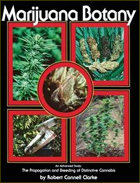
by Robert Connell Clarke
Hardening Off
The cuttings usually develop a good root system and will be ready to transplant in three to six weeks. At this time the hardening-off process begins, preparing the delicate cuttings for a life in bright sunshine. The cuttings are removed and transplanted to a sheltered spot such as a greenhouse until they begin to grow on their own. It is necessary to water them with a dilute nutrient solution or feed with finished compost as soon as the hardening-off process begins. Young roots are very tender and great care is necessary to avoid damage. When vegetative cuttings are placed outside under the prevailing photoperiod they will react accordingly. If it is not the proper time of the year for the cuttings to grow and mature properly (near harvest time, for example) or if it is too cold for them to be put out, then they may be kept in a vegetative condition by supplementing their light to increase daylength. Alternatively they may be induced to flower indoors under artificial conditions.
After shoots are selected and prepared for cloning, they are treated and placed in the rooting medium. Since the discovery in 1984 that auxins such as IAA stimulate the production of adventitious roots, and the subsequent discovery that the application of synthetic auxins such as NAA increase the rate of root production, many new tech niques of treatment have appeared. It has been found that mixtures of growth regulators are often more effective than one alone. IAA and NAA a–e often combined with a small percentage of certain phenoxy compounds and fungicides in commercial preparations. Many growth regulators deteriorate rapidly, and fresh solutions are made up as needed. Treatments with vitamin B1 (thiamine) seem to help roots grow, but no inductive effect has been noticed. As soon as roots emerge, nutrients are necessary; the shoot cannot maintain growth for long on its own reserves. A complete complement of nutrients in the rooting medium certainly helps root growth; nitrogen is especially bene ficial. Cuttings are extremely susceptible to fungus attack, and conditions conducive to rooting are also favorable to the growth of fungus. “Cap tan ” is a long-lasting fungicide that is sometimes applied in powdered form along with growth regulators. This is done by rolling the basal end of the cutting in the powder before placing it in the rooting medium.

